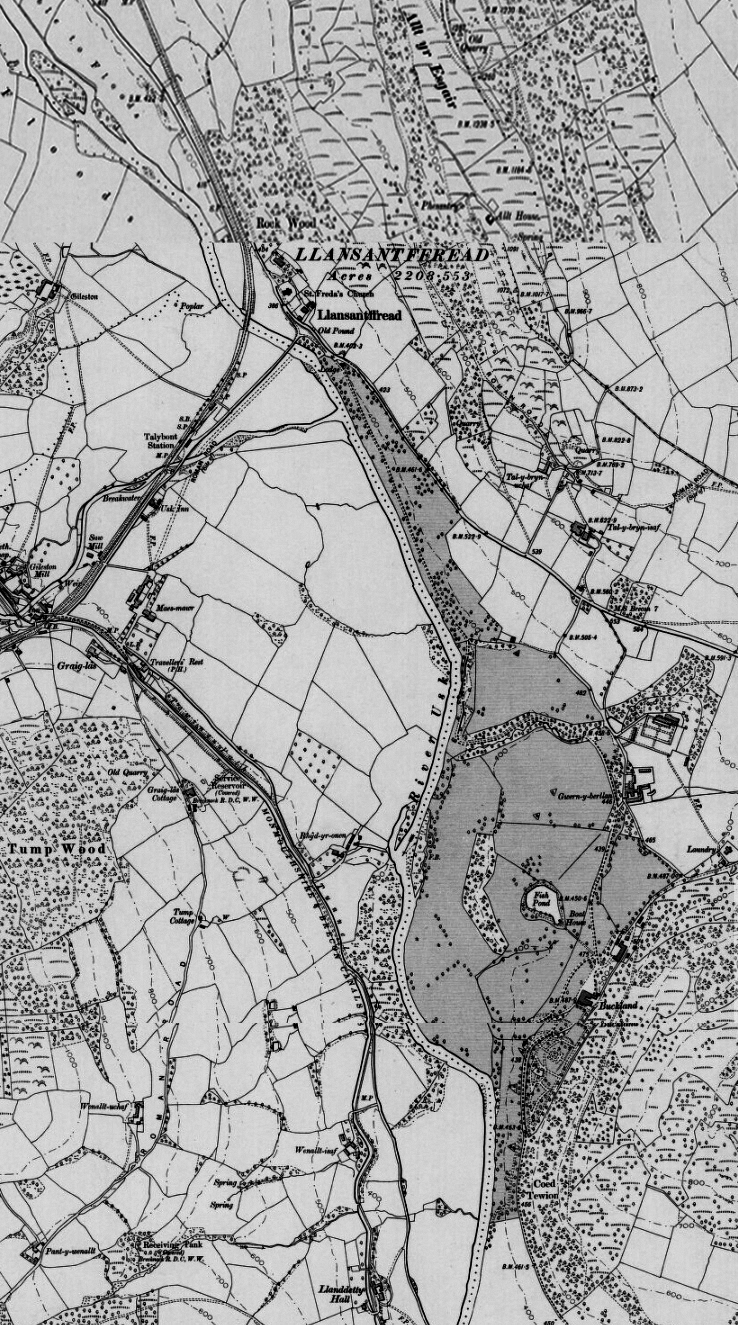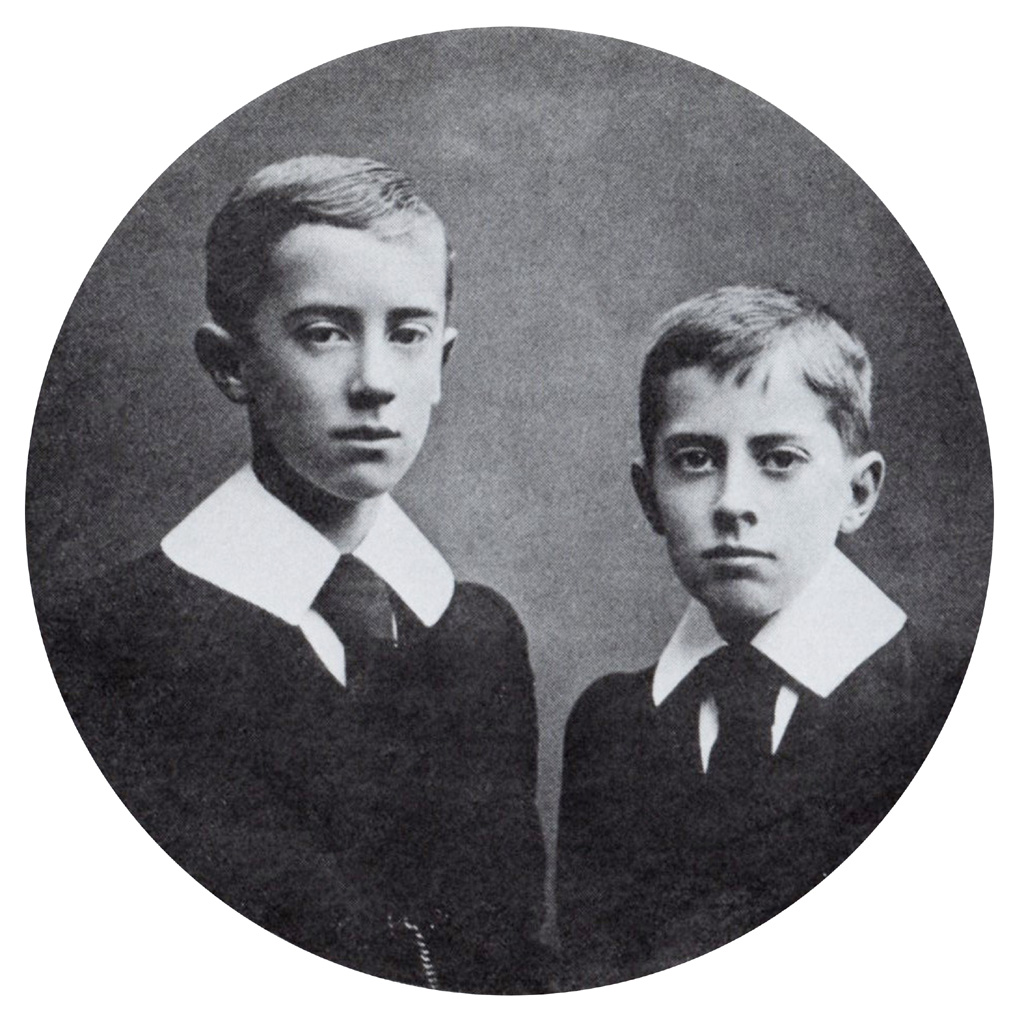THE BUCKLAND OF MIDDLE EARTH
The Brandywine River flows north to south
with Buckland a bulge of land of the left bank. Its boundary is a thick
hedge, the High Hay, that meets the river at the North Gate. Brandy
Hall and the Buckleberry Ferry are marked. A gated tunnel leads under
the Hedge. This was used by Frodo and his companions when they left
Buckland. The Old Forest lies to the east. Crickhollow is the place
where Frodo bought a house. The name is very similar to Crickhowell,
a local village generally referred to as Crick. Girdley Island is situated
upstream of Brandywine Bridge.

Map after the copyrighted 'Part of the Shire' Map in
Lord of the Rings
THE BUCKLAND OF BRECONSHIRE

The Buckland parkland is indicated
by the Ordnance Survey grey stippling.
The Usk River flows north to south with
the Buckland parkland a bulge of land on the left bank. Its boundary
was a double thickness hedge that met the river at the North Gate. Buckland
Hall is marked. A dense forest covers Buckland Hill. An unnamed island
is situated upstream from the railway bridge.

The North Gate and Llansantffraed
Lodge circa 1906.

The Ice House was a brick-lined arched
tunnel that was tunnelled deep under Buckland Hill. This is its portal.

In his childhood Tolkien became fascinated
by trees. The Ents, giant marching trees, first appeared in The Two
Towers.

The location of the Buckland Ferry
across the Usk

Buckland Hall circa 1900. The path
leads up from the ferry.


Report in the Monmouthshire Merlin of an actual
drowing in the River Usk, December 1864
There are clear parallels in these two
accounts of fatalities: a preceding social event, an event held in the
seat of the local magnate, a drowning at night-time, and the vagaries
of a local boat. The puzzle is how did Tolkien hear about this tragedy
of 1864, nearly forty years before? This 1909 Evening Express
clipping provides the answer:

Report in the Evening Express, 1909,
of the death of the son of the drowning victim 45 years before.
Tolkien may have heard first-hand knowledge
of the real event to hatch the demise of Drogo and Primula Brandybuck.
John Cross, the son of the unfortunate Edward Cross, was Head Gamekeeper
at Buckland in 1905 with a son of his own Robert, aged fourteen. Tolkien
may have heard about it from either, the fatality having become almost
legendary, even appearing in a local newspaper as late as 1909, on the
death of John Cross.
The Buckland Ferry, and its 1864 misfortune
recorded in both Breconshire and Middle Earth, is intriguing and suggestive
for placing Tolkien in the Breconshire Buckland. Later, a ferry-boat
was not necessary since after 1910 a footway suspension bridge had been
built across the river in that year. If Tolkien had visited in 1905,
he would have seen the old ferry. The footbridge appears on later maps
but is now derelict.

Cartoon of the clerical procession
crossing the suspension bridge 29th November 1912 for reopening of Llanddetty
Church near Talybont by the determined and famously tall Mary Eleanor
Gwynne-Holford, wife of the Squire.
A JOURNEY TO WALES
Tolkien used variations of Welsh sounds
of places and names in The Lord of the Rings. His imagination had become
engaged by the strange names on the coal trucks he often saw in the
coal yard at King's Heath station on the nearby railway when he lived
in at Westfield Road in Birmingham: Sengenhydd, Nantyglo, Penrhiwceiber
amongst others. In an interview in The Scotsman in 1972, he recalled,
as a small child, seeing the name 'Ebbw' on a railway journey to Wales
and, "never getting over the fascination of the name". Daniel
Grotta, who wrote the first biography of J. R. R. Tolkien, suggests
that the boy's interest in Wales was enhanced by a childhood holiday.
Grotta states, "Shortly after Mabel Tolkien died, Father Morgan,
Tolkien and Hilary went by railway for a fortnight's holiday in Wales".
Mabel died on 14 November 1904, it is reasonable to assume any trip
took place the year after, 1905.
Daniel Grotta records that "Mabel
Tolkien had managed to instil in her older son an almost idolatrous
love of trees, flowers and nature". The magic of the Buckland demesne,
the surrounding mountains, the maze, the exotic foliage in the fernery,
the arboretum with its strange trees, the forests, the Wild Dingle,
the ice-house tunnelled into Buckland Hill, boating on the Fish Pond
or the river, even the recently-built, 1898, 'Tudorbethan' Buckland
Hall itself, with its heraldic carvings of strange beasts in the Great
Hall, may have manifested themselves in The Lord of the Rings.
Trees in the woods on Buckland Hill, planted in military formation by
the Squire's father, a Peninsular War veteran, to represent the fighting
battalions at Waterloo may have excited the young Tolkien's imagination.
He would also have observed the important part ponies, hobbit-sized,
played in life at Buckland. We can speculate that the parkland made
a deep and lasting impression on him, not least because, among the several
hundred names he constructed from real and invented languages that appear
in The Lord of the Rings, an English language place-name shines
through from his childhood unchanged: Buckland. It may have been affection
for this Buckland that led Tolkien's memory to extract it from Breconshire
and implant in Middle Earth on the border of an essentially English
rurality, his beloved Shire. It might be that he was so proud of the
Englishness of The Shire that he was reluctant to confess that he had
attached it to a little part of Wales but as he had used its proper
name, Buckland, maybe he was not that bothered if the truth were to
come out. Possibly his family might be safeguarding its perceived interests
by preventing Buckland in Wales appearing in the Tolkienography using
Non-disclosure Agreements.(Testi
C.A. Pagan Saints of Middle-earth. 97. Zurich: Walking Tree Publishers,
2018).













